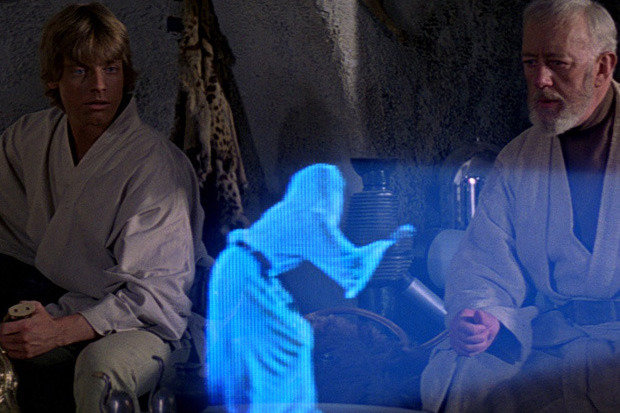While everyone is fixated on AR using smartphones or headsets, the real Future Focus of 3D holograms is emerging from the lab.

Smartphone-based augmented reality (AR) and the AR headset explosion will bring the future focus of 3D holograms into our lives everywhere. Meanwhile, though, the real AR hologram revolution is being ignored.
A hologram is a 3D virtual object that isn’t actually “there,” but looks as if it were, either floating in the air or standing on a nearby desk or table.
The “holo” in Microsoft’s HoloLens headset is a reference to holograms. And when we think of these future AR holograms, we think of headsets, goggles such as HoloLens or smartphones running applications created with Apple’s ARKit or Google’s ARCore.
The future focus of 3D holograms technology is increasingly becoming ubiquitous, and companies are racing to win market domination. A competitor to the HoloLens, the “Lightware” headset from secretive Magic Leap, has been in the news lately, after six years of development at a cost of $2 billion, for two reasons.
The first is that the company unveiled the “Creator Edition” of the headset in December. Now we know what it looks like: something right off the cover of a vintage sci-fi novel.
The second reason is rampant speculation that Apple might buy Magic Leap to accelerate its own AR goggle development, speculation driven by Apple analyst Gene Munster.
In other hologram headset headlines, Dell this week announced that it will start selling, on Feb. 15, the $1,495 Meta 2 developer kits, which include the Meta 2 AR headset, for business deployments. The company said the Meta 2 is supported by several business-class Dell Precision Workstation PCs.
The AR smartphone app experience is emerging now — and the AR headset world is getting closer every day.
So that’s the story on phones and goggles, but what about that “real AR hologram revolution” I mentioned earlier? I will get to that, in the second half of this column. But first, let’s address a basic question.
Think of the future focus of 3D holograms as the next step in making digital content more human-compatible.
Humans see the world in 3D. Our computer and phone screens show us a 2D version of the world. It’s artificial.
If I look at a concept car design on my laptop, people on the other side of the room see only the back of my laptop lid. That’s artificial, too.
A hologram projected in the middle of the room could show a 3D concept car for all to see, as if it were a physical object actually there.
The biggest applications for holograms are for enterprises, such as what I described above — 3D presentations for conference rooms and meetings.
And while we’re deploying holograms in the conference room, we might as well beam live remote meeting participants into the meeting — holographic telepresence.
The future focus of 3D Holograms will also dramatically improve training, design and visualization in enterprises. The ability to look at, zoom in on and manipulate 3D versions of in-progress designs radically enhances the design process.
And, of course, in the marketing department, holograms will thrill customers with experiential marketing campaigns and customer experience interactions.
We’re already seeing applications for all these emerging for smartphone, tablet and headset AR. But the real benefits come when holograms are liberated from such devices.
Holograms without phones or headsets
While dozens or hundreds of major hologram research projects are currently being developed in corporate and university labs around the world, the first examples of this new category are already shipping — or are available to corporate developers.
A company called Realfiction makes an AR product called DeepFrame.
Another approach to AR hologram creation is already shipping from HP.
Meanwhile, a startup called Looking Glass Factory is working on a display product called HoloPlayer
Holographic imagery is also headed to a windshield near you. The most recent example was demonstrated at CES by a company called WayRay.
A different kind of smartphone hologram
Currently, you can get the illusion of a 3D hologram by using any number of smartphone apps created with Apple’s ARKit or Google’s ARCore.
These don’t create 3D holograms — they create a video of a hologram. They combine real-time video feeds with digital objects. The app shows you what the camera sees, then superimposes digital images on top of that real-time video feed. The hologram appears to be a few feet in front of you when you’re looking at the screen.
Researchers are working on the creation of 3D hologram displays for smartphones that project the hologram on or above the surface of the display. Future technology will be able to project 3D holograms into the air above or even around a smartphone display.
The Future focus of 3D Holograms will prove immeasurably useful and powerful for enterprise applications. And this power will be fully realized with technologies more advanced than today’s smartphone apps and tomorrow’s AR headsets.
The job today is to start exploring the solutions now coming online. Several of these offer low-cost development kits, which are ideal for kicking the virtual 3D hologram tires of this emerging new interface.
The world of no-smartphone, no-headset 3D holograms is here.
By Mike Elgan Contributing Columnist, Computerworld | JAN 20, 2018 (Edited)
Recent Comments